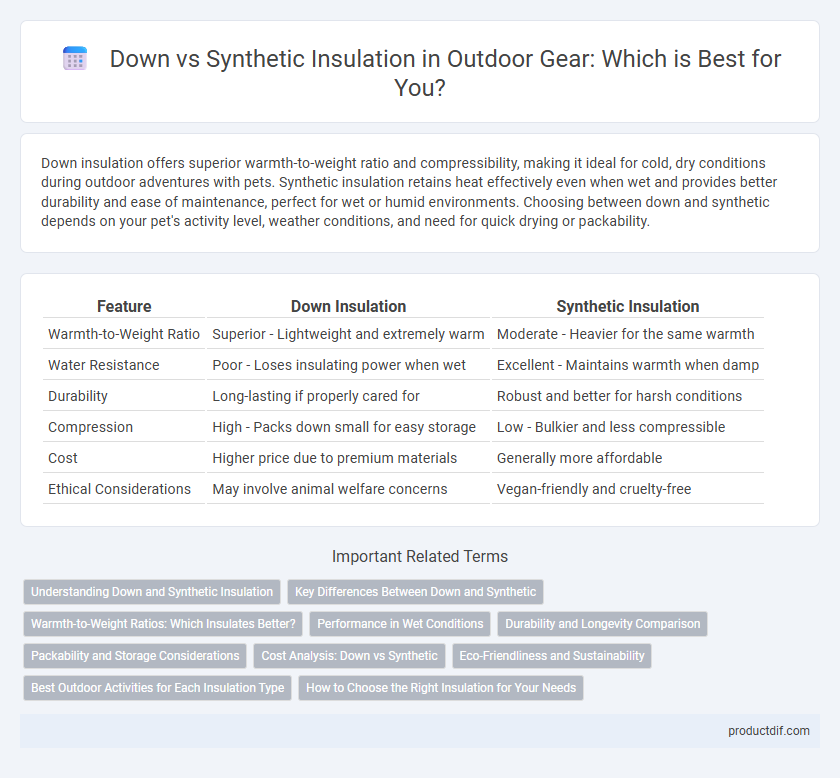Down insulation offers superior warmth-to-weight ratio and compressibility, making it ideal for cold, dry conditions during outdoor adventures with pets. Synthetic insulation retains heat effectively even when wet and provides better durability and ease of maintenance, perfect for wet or humid environments. Choosing between down and synthetic depends on your pet's activity level, weather conditions, and need for quick drying or packability.
Table of Comparison
| Feature | Down Insulation | Synthetic Insulation |
|---|---|---|
| Warmth-to-Weight Ratio | Superior - Lightweight and extremely warm | Moderate - Heavier for the same warmth |
| Water Resistance | Poor - Loses insulating power when wet | Excellent - Maintains warmth when damp |
| Durability | Long-lasting if properly cared for | Robust and better for harsh conditions |
| Compression | High - Packs down small for easy storage | Low - Bulkier and less compressible |
| Cost | Higher price due to premium materials | Generally more affordable |
| Ethical Considerations | May involve animal welfare concerns | Vegan-friendly and cruelty-free |
Understanding Down and Synthetic Insulation
Down insulation offers exceptional warmth-to-weight ratio and compressibility, making it ideal for cold, dry conditions due to its natural cluster structure that traps heat efficiently. Synthetic insulation excels in moisture resistance and retains insulating properties when wet, utilizing polyester fibers to mimic down's loft and warmth. Choosing between down and synthetic depends on activity level, weather conditions, and durability requirements for outdoor gear performance.
Key Differences Between Down and Synthetic
Down insulation offers superior warmth-to-weight ratio and compressibility, making it ideal for ultralight outdoor gear in cold, dry conditions. Synthetic insulation maintains insulating properties when wet and dries faster, providing better performance in damp, humid environments. Durability differences arise as down tends to last longer with proper care, while synthetic fibers resist moisture-related degradation and retain loft after exposure to water.
Warmth-to-Weight Ratios: Which Insulates Better?
Down insulation offers an exceptional warmth-to-weight ratio, making it highly efficient for retaining heat without adding bulk, ideal for ultralight outdoor gear. Synthetic insulation, while generally heavier, maintains insulating properties when wet and dries faster, providing reliable warmth in damp conditions. Choosing between down and synthetic depends on specific outdoor needs, with down excelling in dry, cold environments and synthetic favored for wet or variable weather.
Performance in Wet Conditions
Synthetic insulation outperforms down in wet conditions by retaining warmth even when damp, thanks to its water-resistant fibers that maintain loft and insulating properties. Down insulation absorbs moisture, losing its ability to trap heat and taking longer to dry, which reduces overall performance in rain or snow. Many outdoor enthusiasts prefer synthetic gear for wet environments to ensure consistent warmth and quicker drying times during prolonged exposure to moisture.
Durability and Longevity Comparison
Down insulation excels in compressibility and warmth-to-weight ratio but can degrade faster when exposed to moisture or frequent compression, reducing its overall durability. Synthetic insulation retains insulating properties even when wet and generally withstands repeated use and abrasion better, offering longer-lasting performance in harsh outdoor conditions. Brands focused on durability often choose synthetic materials to ensure consistent insulation and longevity in variable environments.
Packability and Storage Considerations
Down insulation offers superior compressibility, allowing outdoor gear to pack smaller and save valuable space in a backpack. Synthetic insulation, while bulkier, maintains its insulating properties when damp and can be easier to store without specialized care. Choosing between down and synthetic impacts both packability and long-term storage needs based on moisture resistance and material resilience.
Cost Analysis: Down vs Synthetic
Down insulation tends to be more expensive upfront due to its natural sourcing and higher fill power, offering superior warmth-to-weight ratio and compressibility. Synthetic insulation is generally more affordable, providing better performance in wet conditions and easier maintenance, which can reduce long-term costs. Evaluating cost-effectiveness involves considering initial investment against durability and performance in varying outdoor environments.
Eco-Friendliness and Sustainability
Down insulation, sourced from natural goose or duck feathers, offers superior warmth-to-weight ratio but raises concerns about animal welfare and environmental impact due to farming practices. Synthetic insulation, often made from recycled polyester, provides better sustainability by utilizing post-consumer plastics and maintains insulating properties when wet, reducing overall ecological footprint. Brands increasingly prioritize eco-friendly production methods for both materials, emphasizing recycled content and ethical sourcing to advance sustainable outdoor gear.
Best Outdoor Activities for Each Insulation Type
Down insulation excels in lightweight warmth and compressibility, making it ideal for cold, dry conditions such as alpine climbing, winter backpacking, and mountaineering where weight and packability are crucial. Synthetic insulation retains heat better when wet, providing reliable warmth and moisture resistance for activities like kayaking, rainy hiking, and ski touring in damp environments. Selecting the appropriate insulation type based on activity and weather enhances comfort and performance in outdoor adventures.
How to Choose the Right Insulation for Your Needs
Choosing the right insulation for your outdoor gear depends on factors like climate, activity level, and budget. Down insulation offers superior warmth-to-weight ratio and compressibility, making it ideal for dry, cold conditions, while synthetic insulation retains heat when wet and dries faster, suited for damp or variable environments. Consider your typical weather exposure and maintenance preferences to select the most effective insulation that balances warmth, durability, and cost.
Down vs Synthetic Infographic

 productdif.com
productdif.com